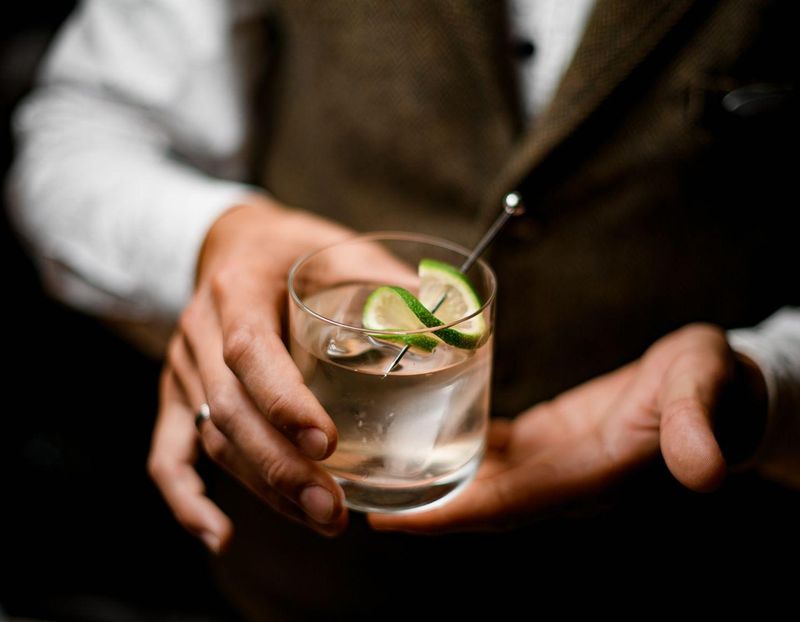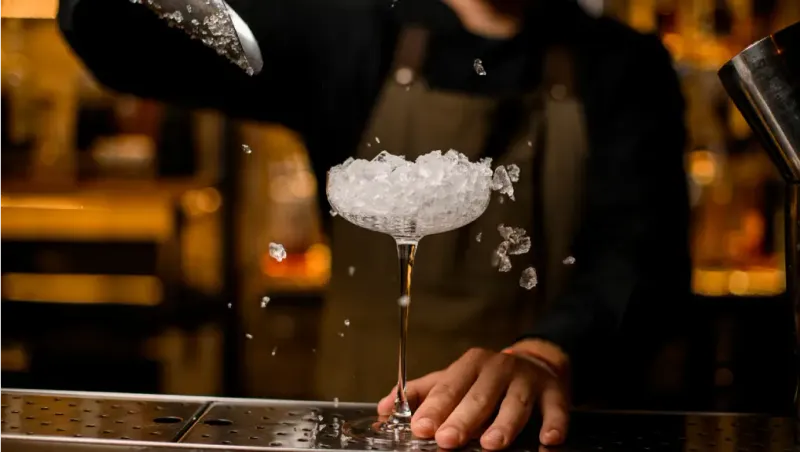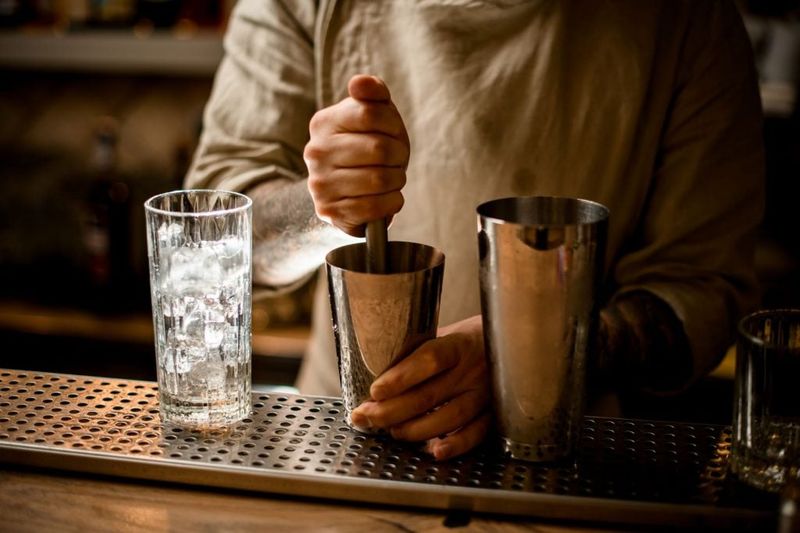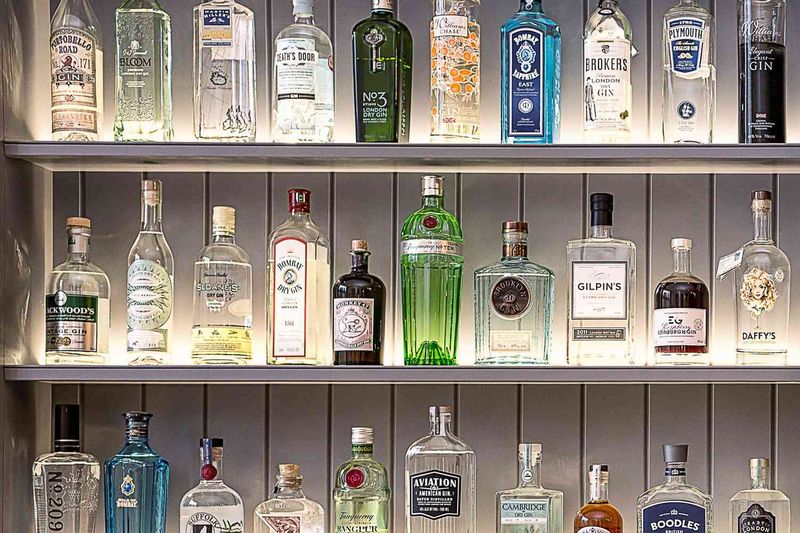Ever walked into a bar and felt something was just… off? Seasoned bartenders know the subtle signals that a night out might turn into a regrettable story. From sticky floors whispering tales of neglect to bartenders who’d rather scroll than serve, these red flags aren’t just annoyances—they can hint at bigger problems you don’t want to discover the hard way. Before you settle in for that cocktail, it pays to know when it’s smarter to close your tab and walk out. Here are 12 warning signs bartenders say should have you heading for the door without hesitation.
1. Bartender Touches Glass Rims
Watch how your bartender handles glassware. When fingers touch the rim where your lips will go, they’re transferring bacteria directly to your drinking surface. Professional bartenders always hold glasses by the base or stem.
This seemingly small mistake indicates poor training and hygiene standards throughout the establishment. The same hands touching money, phones, and bar surfaces are now contaminating your drink.
Experienced bar professionals know this is a cardinal sin in the industry. If you spot this happening, consider it a warning that other unseen hygiene practices may be equally concerning.
2. Filthy Restrooms
Bathrooms tell the true story of a bar’s cleanliness standards. Overflowing trash, sticky floors, and empty soap dispensers aren’t just unpleasant—they’re revealing what happens behind the scenes.
Many bartenders confess that bathroom conditions directly mirror kitchen and bar cleanliness. If management can’t be bothered to maintain public restrooms, they’re likely cutting corners elsewhere too.
Pay attention to details like soap availability and paper towel stock. These basics show whether a bar cares about customer health or simply collecting your money while ignoring sanitation standards.
3. Warm or Flat Draft Beer
That lukewarm, oddly-flavored beer isn’t just disappointing—it’s revealing serious problems. Draft lines require regular cleaning to prevent bacteria, yeast, and mold buildup that ruins flavor and can make you sick.
Knowledgeable bartenders recommend walking out when served flat or warm beer. It signals the bar doesn’t clean lines weekly as recommended, allowing buildup of potentially harmful bacteria.
Good bars maintain proper refrigeration temperatures and clean lines regularly. If your beer tastes off or looks cloudy, trust your instincts—quality establishments take pride in serving properly maintained draft beer.
4. Scooping Ice with Glassware
Shattered glass in ice bins happens more often than you’d think. When bartenders use drinking glasses as ice scoops, they risk microscopic glass fragments contaminating every drink served afterward.
Professional establishments always use designated metal or plastic scoops that hang outside the ice bin. This prevents both breakage and hand contamination of ice that goes directly into your drinks.
Seasoned bar professionals view this shortcut as an immediate danger sign. Glass-in-ice incidents can shut down bars and cause serious injuries to customers—if you see this practice, your safety isn’t being prioritized.
5. Unwashed Bar Tools
Spotting dirty jiggers, muddlers, and shakers scattered across the bar surface should raise immediate concerns. These tools touch multiple ingredients and should be washed between drinks to prevent flavor contamination and bacterial transfer.
A sticky muddler or residue-coated jigger means the bartender isn’t maintaining basic hygiene standards. Cross-contamination becomes especially dangerous for customers with allergies when tools aren’t properly cleaned.
Quality establishments keep sanitizing solutions readily available and regularly rotate tools for cleaning. When bartenders reuse dirty tools, they’re showing a concerning disregard for proper service standards and customer health.
6. Unrefrigerated Vermouth
Spot a bottle of vermouth sitting out at room temperature? Run! This fortified wine spoils quickly once opened unless refrigerated, typically lasting only 1-3 months even when chilled.
Many bartenders admit this common mistake reveals a fundamental knowledge gap about ingredients. A dusty, warm vermouth bottle guarantees your Martini or Manhattan will taste rancid and oxidized.
Quality-focused establishments always refrigerate opened vermouth and date the bottles. This small detail separates professionals who care about drink quality from those just going through the motions without understanding their ingredients.
7. Pre-Made Cocktail Mixes
Those neon-colored jugs behind the bar aren’t just unappealing—they’re a shortcut that sacrifices quality. Real bartenders avoid artificial sour mix, bottled margarita mix, and other pre-made concoctions that contain preservatives and artificial flavors.
Fresh ingredients make dramatically better cocktails. When bars rely on pre-made mixes, they’re prioritizing convenience over quality and likely charging premium prices for inferior drinks.
Look for signs of fresh juice preparation like hand juicers or cut fruit. Respectable cocktail bars squeeze citrus daily and make house syrups from scratch, showing commitment to craftsmanship rather than cutting corners with artificial alternatives.
8. Sticky Floors and Bar Surfaces
Feel your shoes sticking to the floor as you walk? That tacky sensation indicates spilled drinks left uncleaned, potentially for days. Sticky surfaces create perfect breeding grounds for bacteria and attract insects.
Experienced bartenders know that regularly wiping down surfaces prevents buildup and pest problems. When bar tops remain sticky between customers, it shows a troubling pattern of neglect throughout the establishment.
Well-run bars implement cleaning routines during slower periods and after closing. That persistent stickiness isn’t just unpleasant—it reveals management that doesn’t prioritize basic cleanliness standards or staff training on proper maintenance procedures.
9. Fruit Fly Infestation
Those tiny insects buzzing around garnish stations aren’t just annoying—they’re health hazards. Fruit flies indicate poor cleaning practices, especially around drains, garbage areas, and fruit storage.
Professional bartenders know these pests thrive on fermentation. Their presence suggests spills aren’t being properly cleaned and fruit is being left out too long or improperly stored.
Quality establishments implement strict cleaning protocols to prevent infestations. When you spot fruit flies, they’re revealing deeper issues with overall sanitation, potentially affecting everything from garnishes to glassware cleanliness—definitely time to close your tab and find another spot.
10. Distracted Phone-Focused Bartenders
Bartenders scrolling through phones instead of engaging with customers reveals a fundamental service failure. Beyond the obvious customer neglect, this behavior creates safety risks as distracted staff miss overconsumption signs or developing problems.
Professional bartenders maintain situational awareness, keeping eyes on their guests and bar environment. Phone-focused staff often miss drink signals, allow glasses to remain empty, and create an unwelcoming atmosphere.
Quality establishments have strict policies about phone use during shifts. When multiple staff members are engrossed in screens rather than customer service, it indicates poor management and training—clear signs the bar doesn’t prioritize your experience.
11. Unlabeled Well Spirits
Mystery bottles without labels should set off immediate alarm bells. Reputable bars clearly display their well spirits and never refill premium bottles with cheaper alternatives—a deceptive and often illegal practice.
Veteran bartenders warn that unmarked bottles might contain anything from watered-down liquor to completely different spirits than what’s being advertised. This dishonesty extends beyond simple cost-cutting to potentially dangerous misrepresentation.
Quality establishments take pride in their well spirits selection and transparency. When bottles lack proper labeling or staff seems evasive about brands, they’re likely hiding something about what’s actually going into your glass.
12. Overwhelmingly Complex Drink Menu
Massive cocktail menus with dozens of complex options often signal trouble rather than variety. Seasoned bartenders know that quality bars focus on executing fewer drinks exceptionally well instead of offering everything under the sun.
Huge menus typically mean ingredients aren’t fresh since maintaining that many specialized components is nearly impossible. Many items listed likely use the same premade mixers with slight variations to create the illusion of choice.
Look for reasonably sized menus featuring seasonal ingredients and house specialties. When a bar attempts to be everything to everyone, the result is usually mediocrity across the board—a sign the establishment lacks clear identity and quality standards.












Leave a comment